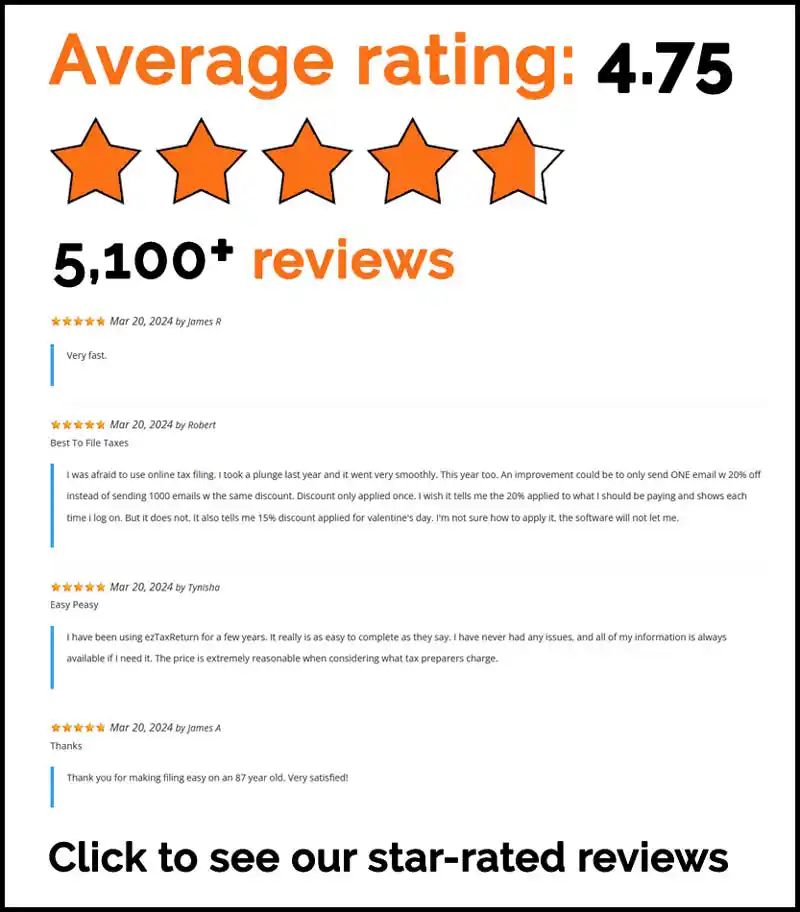The information in this article is up to date for tax year 2025 (returns filed in 2026).
For most people, the highlight of doing their taxes is getting a big fat refund. This is money that can be used to pay off debt, boost your savings or treat yourself to something nice. According to the IRS, the average refund in 2025 was $3,052. If you’re trying to figure out how to get the biggest tax refund, check out our tax tips.
Understanding Tax Refunds
What determines how big your tax return is?
The size of your tax return hinges on several key factors, including your filing status, taxable income, and the number of dependents you claim. Additionally, the tax credits and deductions you qualify for can significantly impact your refund. For instance, if you’re eligible for the child tax credit, you could see a substantial increase in your tax return. Similarly, itemizing your deductions instead of taking the standard deduction can reduce your taxable income, potentially leading to a bigger tax refund. Understanding these elements can help you strategize and maximize your refund.
How do tax returns work?
When you file your tax return, you’re essentially reporting your income and tax payments to the IRS, which then calculates your tax liability for the year. The IRS uses this information to determine your taxable income, place you in the appropriate tax bracket, and calculate your total tax bill. If you’ve overpaid your taxes throughout the year, you’ll receive a tax refund. Conversely, if you’ve underpaid, you’ll owe taxes to the IRS. Your filing status—whether single, married filing jointly, or head of household—also plays a crucial role in determining your tax liability and, consequently, your tax refund.
Adjust Your Tax Withholding
When you first started your job, you completed a W-4 which told your boss how much taxes to withhold from each check. Receiving a tax refund simply means you withheld and paid too much to the IRS, and now the government is giving you back your money.
If you want to get a bigger tax refund, adjust your withholding by submitting a new W-4 to your employer. In other words, you’ll want to claim less allowances so more taxes will be withheld from your pay. Keep in mind that although you’ll get a larger refund at tax time, your paycheck will be smaller throughout the year.
Increase Your Retirement Contributions
A smart way to boost your refund is to save for retirement. Increasing retirement contributions can lower your adjusted gross income, thereby reducing your taxable income and potentially increasing your tax refund. Since traditional IRAs and 401Ks are funded with pre-tax dollars, any contributions you make will lower your taxable income dollar for dollar. As long as you don’t exceed the contribution limit, you can sit back and watch the tax savings pile up. For 2025, the maximum you can contribute to a 401K is $23,500 ($31,000 if you’re aged 50 or older). Meanwhile, IRAs have a contribution limit of $7,000 ($8,000 if you’re aged 50 or older).
For 2026, the 401K contribution limit will increase to $24,500. The annual IRA contribution limit will rise to $7,500.
Don’t Take the Standard Deduction if You Can Itemize
Don’t automatically assume that taking the standard deduction is the right choice for you. If your tax deductions and other deductible expenses exceed the standard deduction for your filing status, itemizing may be worth the effort.
Standard Deduction Amounts for Tax Year 2025
| Filing Status | Standard Deduction |
|---|---|
| Single; Married Filing Separately | $15,750 |
| Married Filing Jointly & Surviving Spouses | $31,500 |
| Head of Household | $23,625 |
Standard Deduction Amounts for Tax Year 2026
| Filing Status | Standard Deduction |
|---|---|
| Single; Married Filing Separately | $16,100 |
| Married Filing Jointly & Surviving Spouses | $32,200 |
| Head of Household | $24,150 |
Here’s a list of expenses that qualify for itemized deductions:
- Home mortgage interest
- State and local income taxes or sales taxes
- Real estate and personal property taxes
- Charitable contributions
- Unreimbursed medical and dental expenses
When you do your taxes with ezTaxReturn, we automatically compare your standard and itemized deductions so you can choose the option that saves you the most money.
Contribute to a Health Savings Account
If you have a high-deductible health plan (HDHP), understanding the current HSA contribution limits can help you maximize tax savings and plan for medical expenses. Below is a simple breakdown of how much you can contribute to a Health Savings Account in 2025-2026.
2025 HSA Contribution Limits Chart
| Category | 2025 HSA Contribution Limit |
| Individual (Self-Only) | $4,300 |
| Family Coverage | $8,550 |
| Catch-Up Contribution (Age 55+) | $1,000 |
2025 HSA Contribution Limits Chart
| Category | 2026 HSA Contribution Limit |
| Individual (Self-Only) | $4,400 |
| Family Coverage | $8,750 |
| Catch-Up Contribution (Age 55+) | $1,000 |
You have until the tax filing deadline to make contributions to tax-advantaged accounts like traditional IRAs and HSAs.
Rethink Your Filing Status
Choosing the right tax filing status can be a huge money saver. Normally, people who aren’t married select single as their filing status without much thought. However, if you’re unmarried and pay more than half of the household expenses for you and a qualifying person, filing head of household may be a better fit.
The main reason to make the switch is because the standard deduction is higher. The standard deduction is $15,750 for single filers and $23,625 for head of household. That’s $7,875 you’ve instantly saved without any effort.
If you do your taxes with ezTaxReturn, you can prepare multiple returns free, each with a different status, to see which gives you the biggest tax refund before you file.
Claim Every Tax Break You Deserve to Get the Biggest Tax Refund
Every year one in five eligible workers misses out on the Earned Income Tax Credit (EITC) due to lack of awareness. The dependent care credit helps offset care expenses for qualifying dependents, which is crucial for working parents and others needing care. Eligibility requirements and recent changes, such as those from the American Rescue Plan, can affect how this credit is claimed.
For tax year 2025, the EITC credit ranges from:
- Up to $8,046 with three or more qualifying children
- Up to $7,152 with two qualifying children
- Up to $4,328 with one qualifying child
- Up to $649 with no qualifying children
That’s up to $8,046 you’re letting slip through your fingers. (Check your EITC eligibility).
The key to minimizing your tax liability and reducing your tax bills is to take advantage of every credit and deduction you’re eligible for. An easy way to ensure you don’t miss out is to use tax software like ezTaxReturn to prepare your return. Our simple question and answer format makes it easy to maximize your credits and deductions so you get the biggest possible refund, guaranteed.
File with ezTaxReturn for Easy, Stress-Free Tax Filing
Filing your taxes with ezTaxReturn makes filing your taxes easy and stress-free. Our simple, user-friendly tax preparation software ensures you don’t miss any opportunities for tax savings. With ezTaxReturn, you can take full advantage of all the tax credits and deductions you’re eligible for, helping you maximize your refund. Plus, we stay up-to-date with the latest tax law changes, so you can file confidently and get the biggest refund possible. Don’t leave money on the table, file with ezTaxReturn today!
Frequently Asked Questions
How can I get a bigger tax refund?
You can increase your tax refund by claiming all eligible tax deductions and credits, contributing to retirement or HSA accounts, and accurately reporting your income.
What tax deductions help maximize a refund?
Common tax deductions include student loan interest, mortgage interest, medical expenses, charitable donations, and business expenses if self-employed. Itemizing may increase your refund compared to taking the standard deduction.
Which tax credits directly increase my refund?
Tax credits like the Earned Income Tax Credit (EITC), Child Tax Credit, and education credits reduce your tax bill dollar-for-dollar, often boosting your tax refund.
Can adjusting my W-4 lead to a bigger tax refund?
Yes. Increasing withholding on your W-4 can result in a larger refund at tax time, but it will reduce your take-home pay throughout the year.
How do retirement contributions affect my tax refund?
Contributing to a traditional IRA, 401(k), or Health Savings Account (HSA) reduces taxable income, which can increase the size of your tax refund.
Does filing early help me get a bigger refund?
Filing early doesn’t change the amount of your tax refund, but it can help you get your money faster and reduce the risk of delays or errors.
Can filing jointly with my spouse increase my refund?
Yes. Married couples who file jointly often qualify for higher deductions and credits, which can result in a larger tax refund than filing separately.
Are dependents important for maximizing a refund?
Claiming dependents can qualify you for credits like the Child Tax Credit and Dependent Care Credit, both of which can significantly boost your tax refund.
How can self-employed individuals increase their refund?
Self-employed taxpayers can deduct business expenses, home office costs, health insurance premiums, and may qualify for the Qualified Business Income (QBI) deduction to reduce taxes and increase refunds.
How do I track my tax refund after filing?
Use the IRS “Where’s My Refund?” tool online or the IRS2Go mobile app to track the status of your refund from submission to deposit.
Can small tax changes really make a difference?
Yes. Even small adjustments, like tracking overlooked deductions or credits, can add up and noticeably increase your tax refund.
Can tax software help me maximize my refund?
Yes. Reliable tax software can guide you through deductions and credits, catch mistakes, and help you claim everything you’re eligible for to get the biggest tax refund possible.
The articles and content published on this blog are provided for informational purposes only. The information presented is not intended to be, and should not be taken as, legal, financial, or professional advice. Readers are advised to seek appropriate professional guidance and conduct their own due diligence before making any decisions based on the information provided.




